Geothermal vs Ground-Source Energy: What’s the Difference?
Lots of naturally-occurring (low-carbon) heat is underground. Using it to generate electricity and provide heat for our buildings and processes is becoming more common.
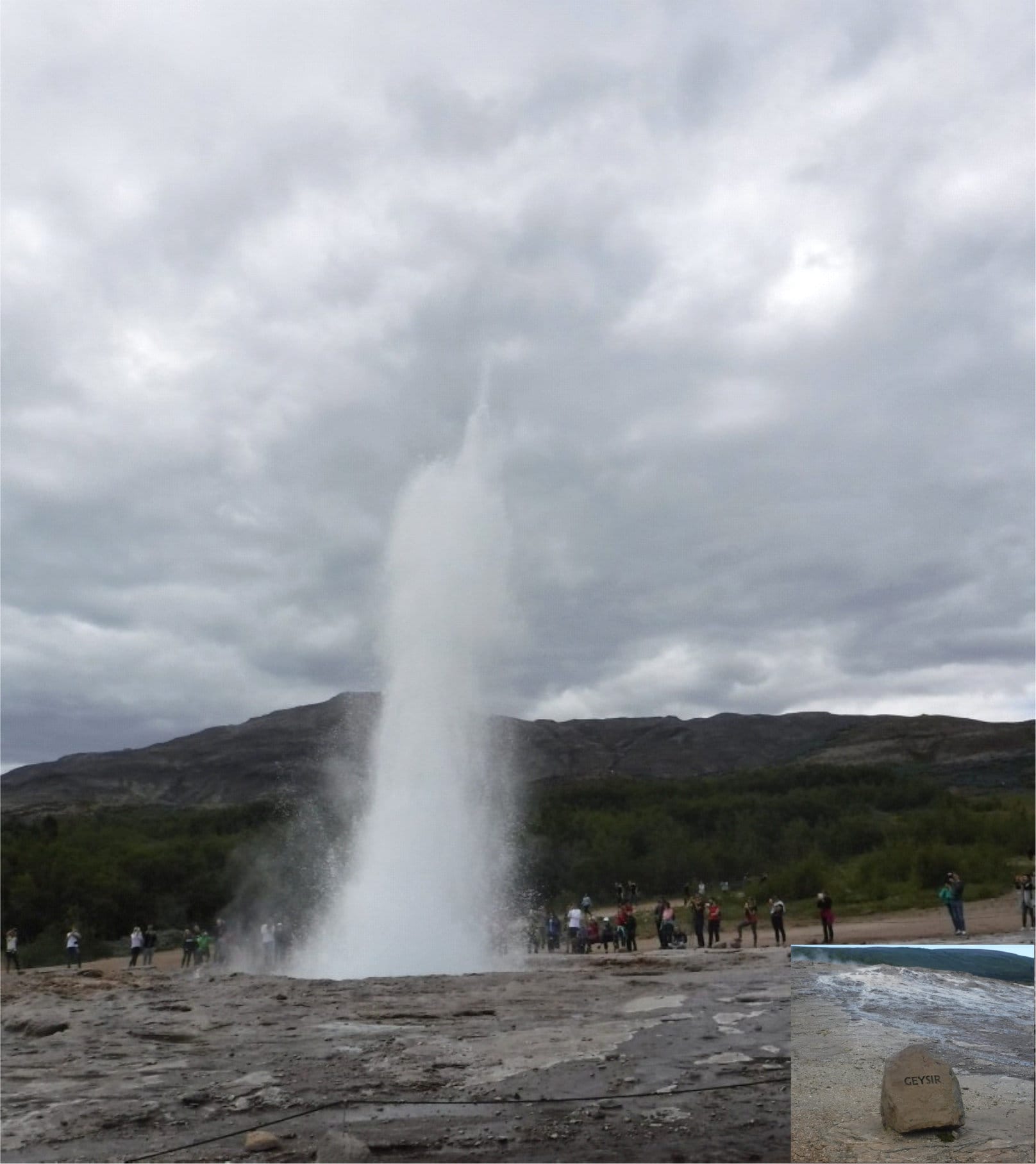
As a twelve-year-old growing up in a suburb of a city on the North American prairies, I witnessed an event that provided me with an intuitive feel for climate, one that has stuck with me. The full heat of mid-summer in the northern hemisphere (July) had arrived, and work crews from the city had dug up the street near our house to replace some piece of buried infrastructure. I was shocked to see ice down the sides of the excavation. While the soil was thawed from the surface down about a metre, the soil for the next metre below that was still frozen, with ice clearly visible, and below about two metres depth, the soil was ice-free again. I could not understand how, when gardens were in full growth, deciduous trees were in full leaf, and fruit trees were setting fruit, the ground could still be frozen.
The answer, as I found out then, and put numbers to later when I studied engineering, is near-surface soil temperatures are subject to the vagaries of weather and climate. A pulse of warm-weather heat travels down into the soil over the summer and fall, while in the winter the soil’s heat is released back to the cold weather above, with snow and vegetation acting as an insulating blanket to reduce the soil heat loss. Where there is no snow, as on the roadway by our house, the cold can penetrate deeply and persist, as I saw.
Go a little further down below the frost line, and the ground temperature remains essentially constant, at a temperature that is roughly related to the mean annual air temperature for the location but varying with annual sunshine, snow cover, soil moisture content, and soil type.
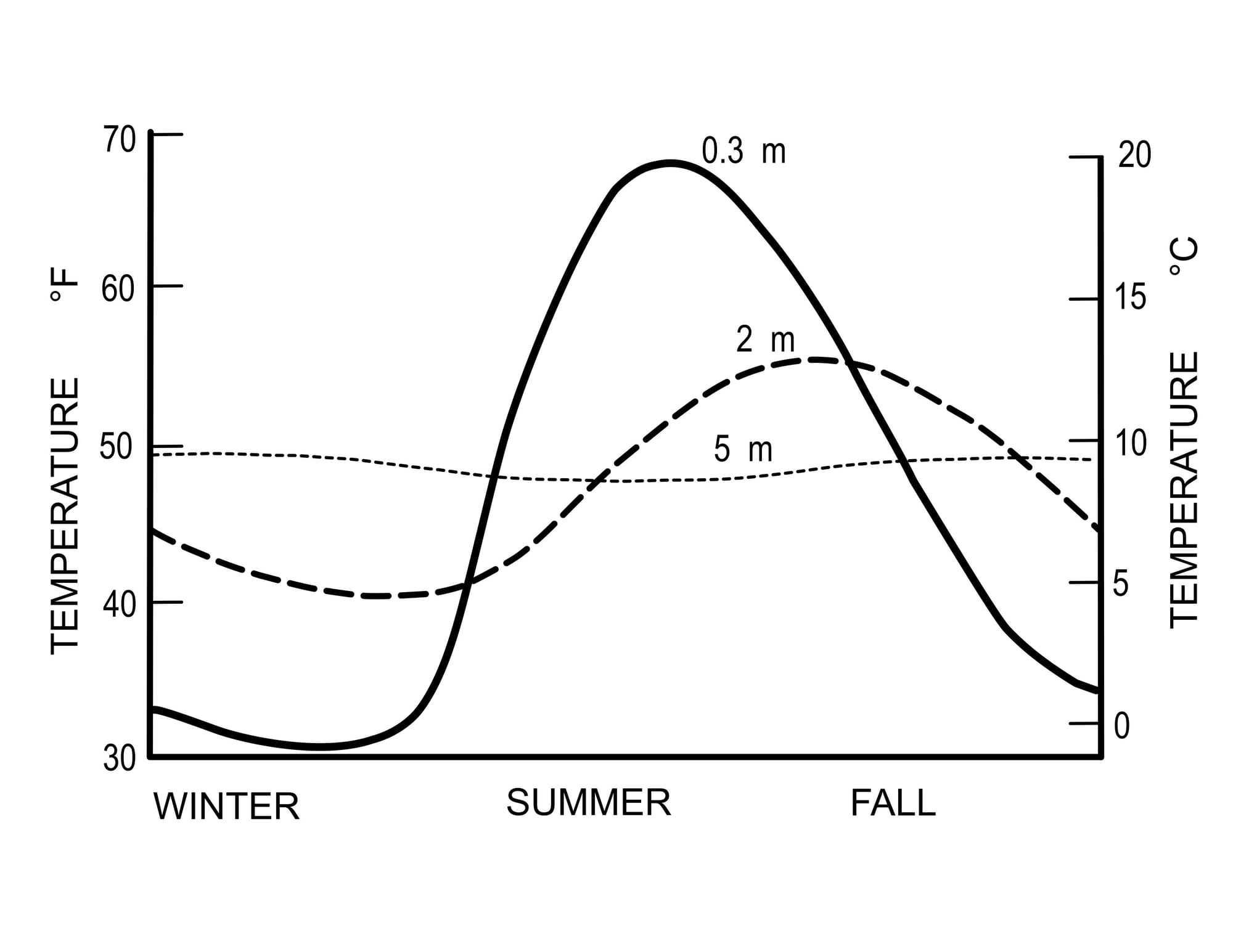
Ground-source Heat Pumps
In cold climates like Canada, that near-constant underground temperature (at, say, 5 metres depth) is usually well above freezing, around +10 degrees Celsius (50 degrees Fahrenheit) as shown by the example of Ottawa. A winter underground temperature of +10°C is well above the average Ottawa winter air temperature (about -10°C, +14°F, in January), and the difference between the two presents an opportunity to extract heat for use in heating buildings.1
Of course nobody keeps their house at 10°C, so although 10°C air contains heat, it is low grade, not directly usable, and needs to be upgraded. We do that with heat pumps.
A quick refresher on heat pumps. They are essentially a refrigerator or air conditioner run backwards. In a fridge or air conditioner, we cool down the food or the room by extracting their heat with an evaporation-compression cycle driven by an electric motor, and expel the unwanted heat out of a condenser coil at the back. In a heat pump, it’s the heat side of the cycle we want (at least in heating mode - they can also be reversed to provide cooling, just like a refrigerator), and we most commonly extract it and upgrade it from cool or cold outside air. That technology is known as an air-source heat pump, and you may have one, or at may least have seen one.
For every unit of electrical energy we put into the heat pump cycle we get several more units of heat out, depending on the temperature of the cool/cold source. The exact multiple is known as the Coefficient of Performance (COP), and is a direct measure of efficiency, where a bigger number means a more efficient machine. Here’s the counter-intuitive thing about heat pump efficiency. The COP is not a fixed number for any given heat pump. The COP is highly dependent on the temperature of the source. If that source is 8 - 10°C, the COP may be as high as 4 or 5, but at -10°C, the COP is likely to drop to much less than 2, or even as low as 1, at which point the heat pump is no more efficient than direct electric resistance heating.
You can see where we are going with this.
What if our heat source, instead of being outside air in winter at -10°C, is the ground 5 m down, at +10°C? Now we can run our heat pump at a near-optimum condition with a high COP. That is the basis of ground-source heat pumps. Implementing such systems is a matter of straightforward engineering and economics that depends on soil types, the cost of drilling bore holes down to where the warm soil is, and details of heat pump and coolant piping system design.
That’s the thermodynamics, but what practical difference do heat pumps make? A 2024 study estimated a 5-9% reduction in USA national emissions from full adoption of air-source residential heat pumps.2 How much difference in greenhouse gas (GHG) reduction would result from using ground-source heat pumps instead of air-source heat pumps? Other studies have shown an additional 20 - 24% reduction in GHGs.3
Geothermal Heat Systems
Now you are thinking, what happens to the ground temperature if we go even deeper? It’s a good question. The answer is a phenomenon known as the geothermal gradient, where the ground gets even warmer the deeper you go.
Why is that?
For two reasons. The first is leftover heat from the formation of the Earth billions of years ago, which accounts for about half the heat in the deep Earth. The second is radioactive decay of elements like uranium, thorium and potassium in the lithosphere and mantle, which accounts for the other half of deep earth heat.4
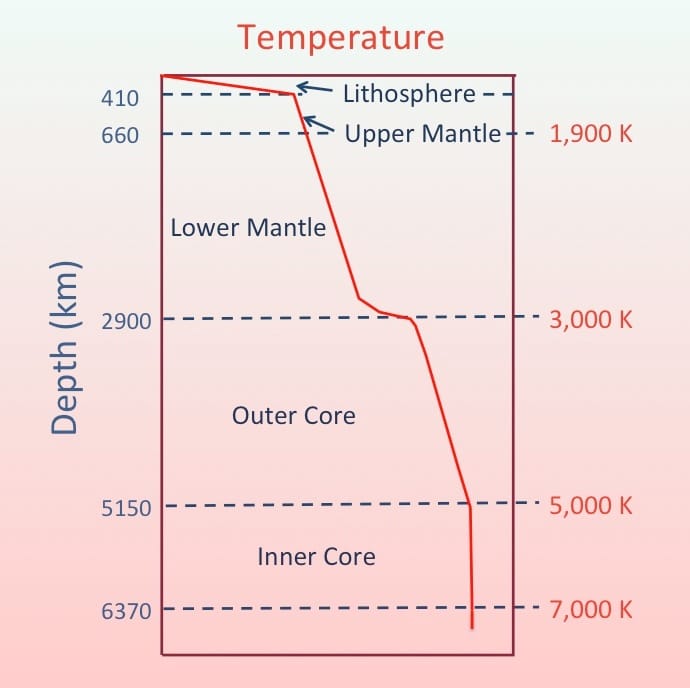
The global average rate of heat increase with depth (geothermal gradient) is about 25 degrees C for every one kilometre of increased depth. This gradient varies greatly with location. A borehole drilled in Ottawa in 1978 recorded an actual geothermal gradient of 14.2°C/km of depth, much less than the global average.

At the other end of the range of the geothermal gradient are places like Iceland, which is a large, geologically young volcanic island. In many places in Iceland, the ground is so hot at relatively shallow depths that pure groundwater can be piped directly, without a heat exchanger, from shallow wells into steam turbines to generate electricity. In many other locations in Iceland, while the groundwater is not hot enough to generate electricity, it is hot enough to heat buildings via a district energy system. Iceland’s capitol city of Reykjavik is heated this way.
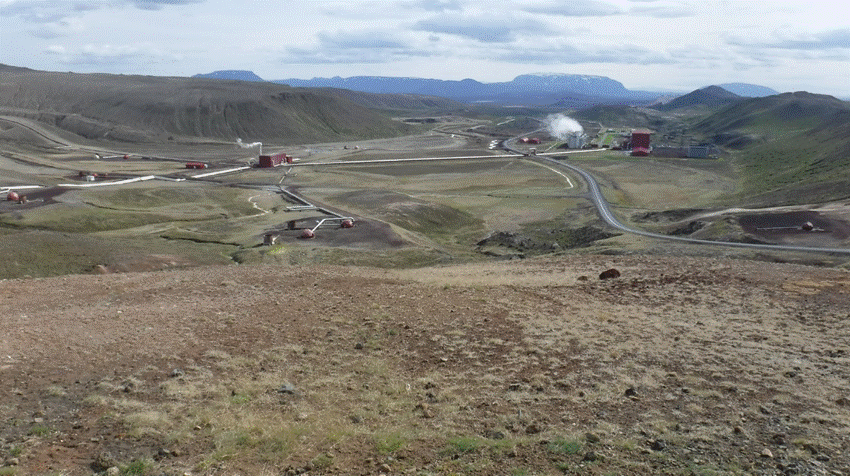
If you are not fortunate enough to live on top of a volcano, the geothermal gradient where you do live likely means, at moderate depths (from a drilling or mining perspective) you can reach ground temperatures of 50°C, which is about the temperature at which most air-to-water heat pumps supply heat to buildings.
As one example of geothermal potential, the province of Alberta in Canada has mapped the geothermal gradient for much of its territory and has found that the gradient varies from 23°C/km in the coolest parts of the province to nearly 49°C/km in the warmest parts.5 This means that heat at usable temperatures is directly available at drilling depths of 1 - 2 km. For a jurisdiction that has a vast amount of expertise in drilling for fossil fuels, these depths are readily accessible.

The fairly wide range of temperatures in the geothermal gradient across Alberta nicely illustrates the possibilities for exploiting the available heat. At the upper end, about 49°C, the heat can be used directly. At the lower end, about 23°C, the heat can be extracted with heat pumps, and as long as the electricity running those heat pumps is low carbon, the GHG footprint of the resultant heat is lower than fossil-fuel heat.
Direct geothermal heat is currently used for many purposes around the world. A 2020 review estimated the distribution as shown in the following figure:6
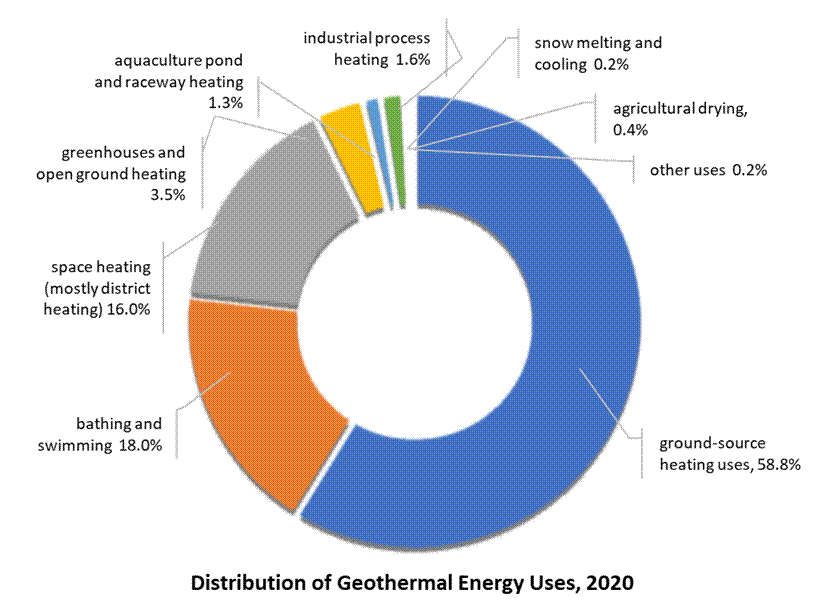
The geothermal energy used in 2020, the last year we seem to have solid numbers for, was 1.021 exajoules/yr, and was then growing at a compound rate of 11.5 % annually.
What is the potential total geothermal energy available globally?
An exact number is not possible due to many uncertainties around the rate of technological advance and policy choices. The Intergovernmental Panel on Climate Change (IPCC) has estimated that geothermal energy could deliver as much as 11.8 exajoules/year (EJ/yr) by 2050,7 which equates to almost twice as much energy as was used in the entire USA for all residential space and hot water heating in 2024.8
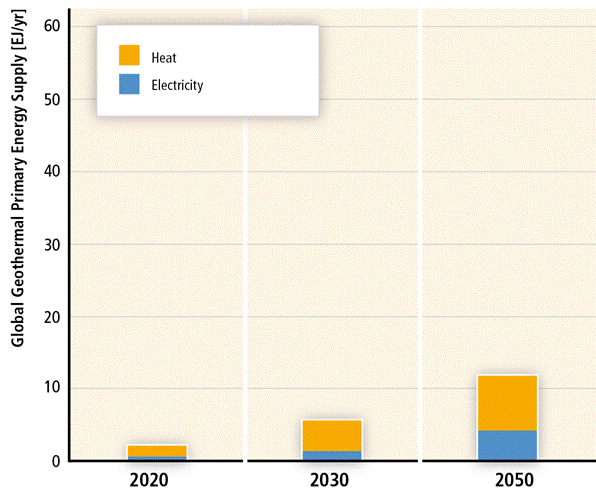
From another perspective, 11.8 EJ/yr will be about 2% of total global projected energy demand in 2050. 2% may not seem like much, but it is roughly the same fraction that is currently used by the global aviation industry.
Notwithstanding the IPCC estimate, technology may advance faster and costs may come down quicker, enabling geothermal energy to play a bigger role in our low carbon energy future.
Reading
- Canada, Government of Canada National Research Council. Canadian Building Digest CBD 180, 1976, retrieved from “Ground Temperatures - NRC Publications Archive.” October 11, 2025. https://nrc-publications.canada.ca/eng/view/object/?id=386ddf88-fe8d-45dd-aabb-0a55be826f3f.
- Wilson, Eric J. H., Prateek Munankarmi, Brennan D. Less, Janet L. Reyna, and Stacey Rothgeb. “Heat Pumps for All? Distributions of the Costs and Benefits of Residential Air-Source Heat Pumps in the United States.” Joule 8, no. 4 (2024): 1000–1035. https://doi.org/10.1016/j.joule.2024.01.022.
- Aresti, Lazaros, Paul Christodoulides, and Georgios A. Florides. “An Investigation on the Environmental Impact of Various Ground Heat Exchangers Configurations.” Renewable Energy 171 (June 2021): 592–605. https://doi.org/10.1016/j.renene.2021.02.120.
- “Geothermal Gradient - Energy Education.” Accessed October 12, 2025. https://energyeducation.ca/encyclopedia/Geothermal_gradient.
- Alberta Geological Survey. “Geothermal Atlas of Alberta.” Accessed October 15, 2025. https://ags.aer.ca/our-science/geothermal-energy/geothermal-atlas-alberta.
- Lund, John W., and Aniko N. Toth. “Direct Utilization of Geothermal Energy 2020 Worldwide Review.” Geothermics 90 (February 2021): 101915. https://doi.org/10.1016/j.geothermics.2020.101915.
- “Geothermal Energy — IPCC.” Accessed October 15, 2025. https://www.ipcc.ch/report/renewable-energy-sources-and-climate-change-mitigation/geothermal-energy/.
- “Residential Energy Consumption Survey (RECS) - Energy Information Administration.” Accessed October 21, 2025. https://www.eia.gov/consumption/residential/.